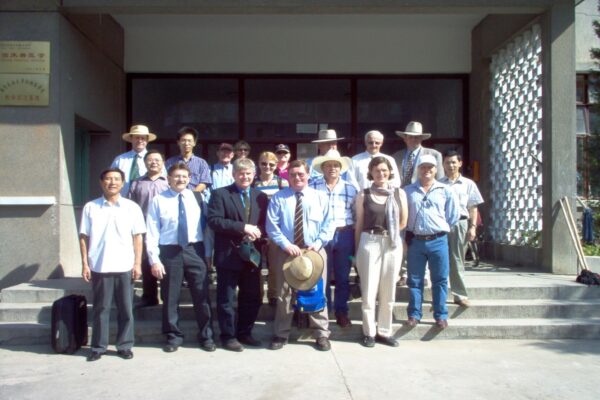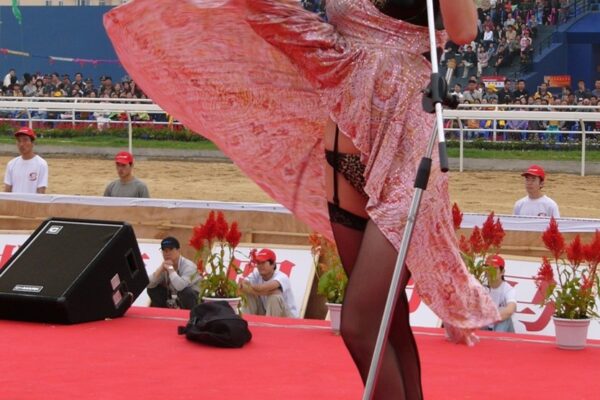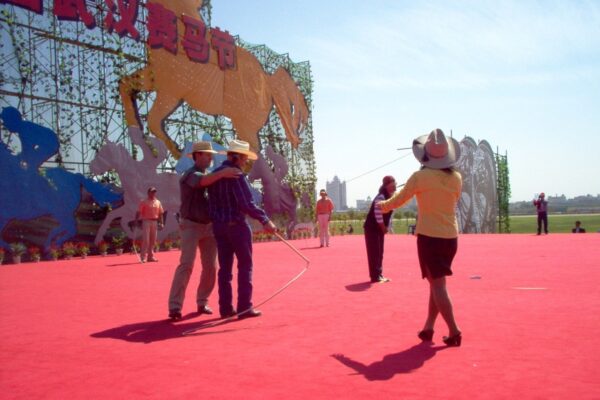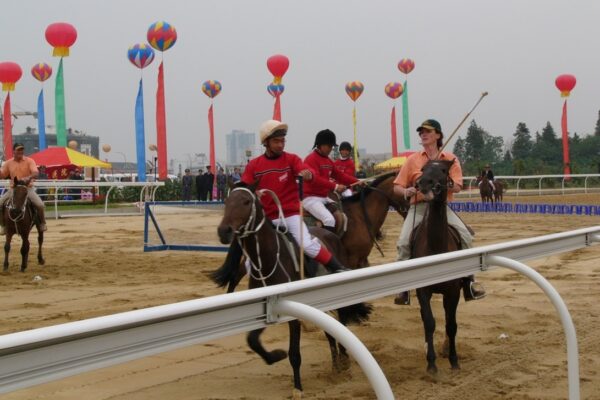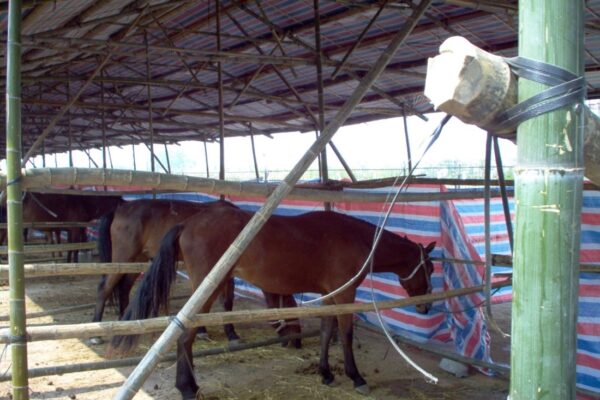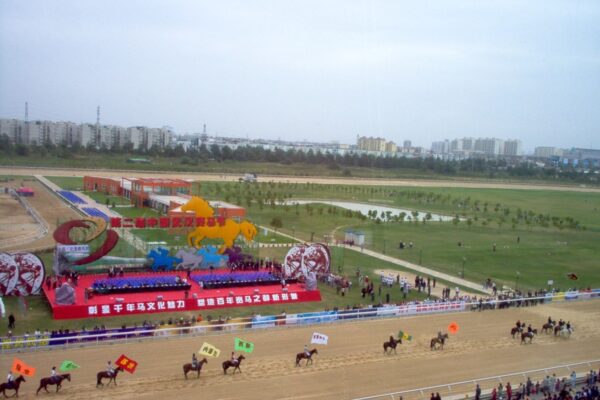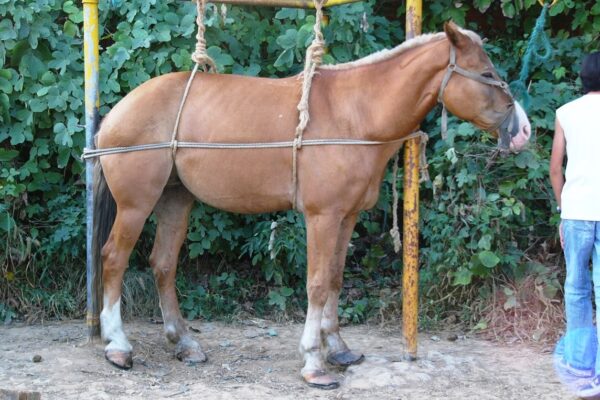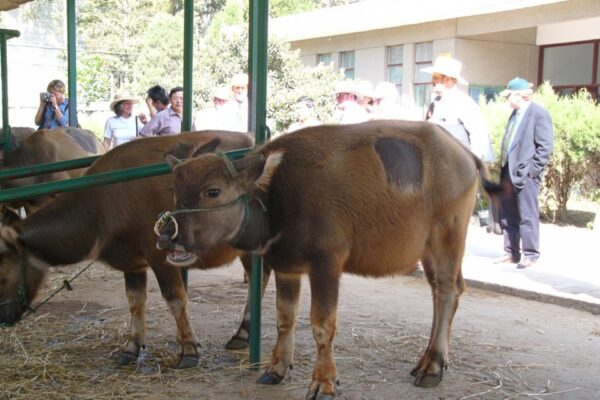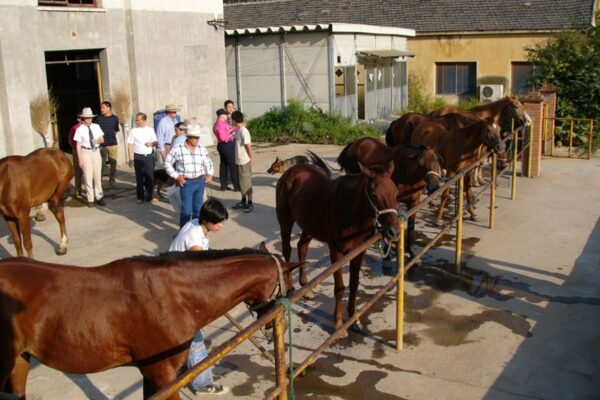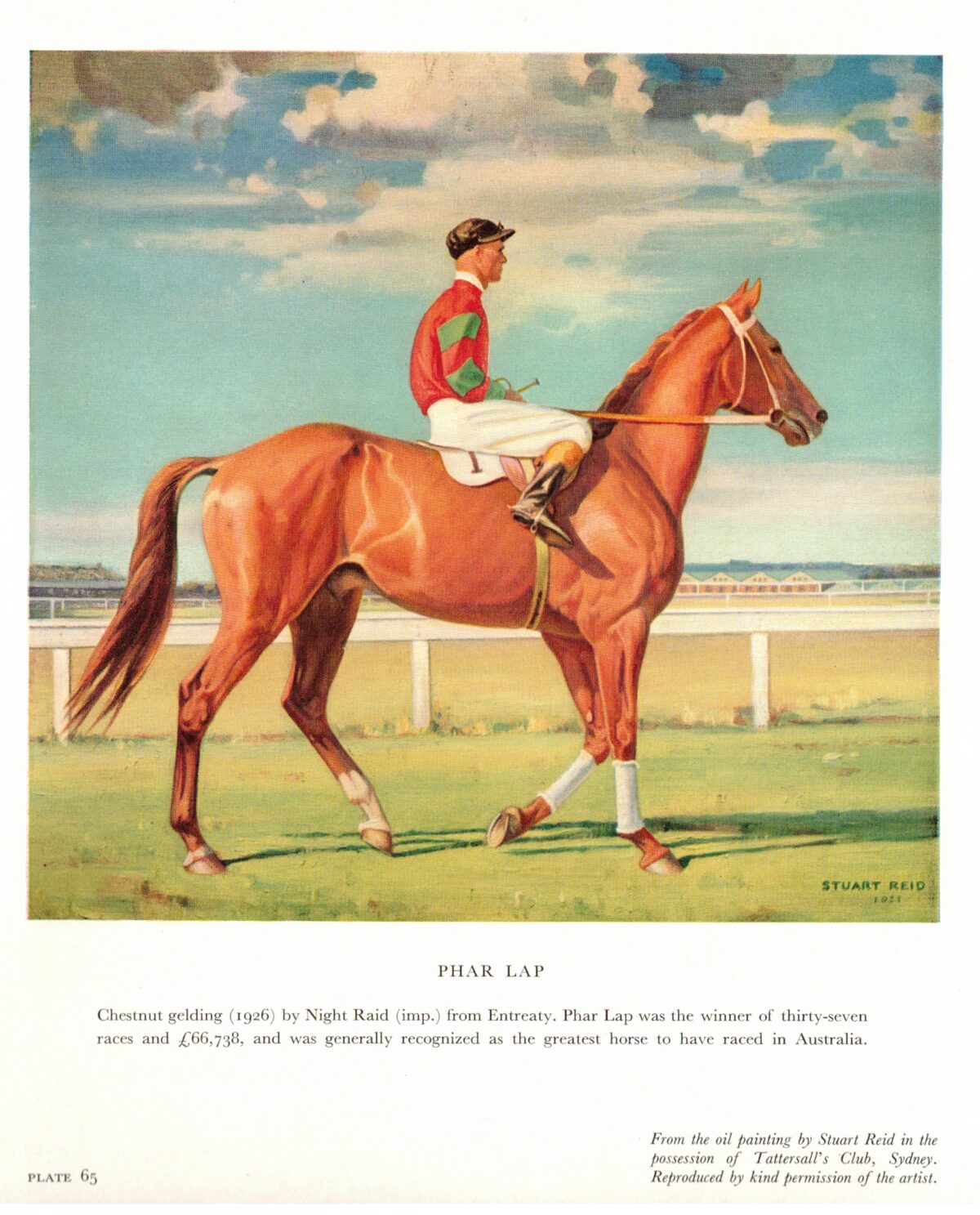Phar Lap: The best there ever was?
by Mandy Logan | Oct 22, 2021 | 2012-2014
17th October 2005
See: https://www.horseinsurance.com.au/phar-lap-the-best-that-ever-was/
Phar Lap: “The best that ever was?” by Ross Stapleton.
October 20, 2005 finally sees the DVD release of “Phar Lap” – the best Australian sports movie ever made. His legend remains familiar to generations as one of our two greatest sporting icons alongside Bradman. But while our most revered champion racehorse – was he “the best that ever was”?
Saturday 22nd October 2005 will mark the 75th anniversary of Phar Lap’s first Cox Plate win in 1930, before going on to launch himself into the most extraordinary domination of a Melbourne Cup Carnival ever seen a week later.
Yet amazingly he escaped an attempt on his life after being shot at from a passing car while out walking just hours before he raced and easily won the Melbourne Stakes on the opening Derby Day Saturday, just three days before the most famous Melbourne Cup win of them all.
Not only did he win the Cup by several lengths with ease, set a new weight carrying record for a four-year old and send a whole clutch of bookies broke as the shortest priced favourite to win the race (11/8 on), but also won on all four days of the carnival. No wonder on his racing record alone it’s a given that there will never be another Phar Lap.
His freakish ability to win at all distances and lump weight and still win with ease created a palpable aura of invincibility. But how could you not respond to a horse who between September 29, 1929 and his last race in Mexico on March 20, 1932: raced 41 times and was only unplaced in one race – the 1931 Melbourne Cup when “carrying the Grandstand” as Scobie Breasley recently observed. He had two second and two third placed runs and otherwise blitzed the biggest races on the calendar, including the world’s then richest race in Mexico, to win 36 times.
Of course, his domination of Australian racing also coincided with the Great Depression as bookies took a “belting” from the battlers, who as true believers religiously bet on the champ to win at a time when the nation had an unemployment rate of 30%. So, was it any wonder as he carried their hopes that this huge gelding forged an unbreakable bond with the public as he won race after race?
Yet it’s not just because of his amazing deeds on the track, let alone his claim to be the greatest racehorse ever foaled in any country; but his wider story that really is the stuff of legend.
He was so extraordinary that officials changed the rules of racing in an attempt to weight him out of events, which was why eventually when crippled with too much weight in the 1931 Melbourne Cup, which became his final race in Australia, his American half-owner David Davis agreed to accept an invitation to take on the best horses in the Agua Caliente Handicap held just across the Mexican border at Tijuana in 1932, for what was then the biggest stake in racing: US$50,000.
Phar Lap’s death sent Australia into mourning. Yet just 16 days after that momentous win when he broke the track record while only 75% fit after earlier injuring a hoof and with a limited preparation at best, he died near San Francisco in mysterious circumstances that is still talked about and debated to this day. Upon hearing news of his death, the Australian public felt a profound sense of being robbed of a favourite son; which put the final seal on his veneration that transcended horseracing – and which has in the following decades only served to add an emotive and hugely nostalgic aura to his legendary reputation. Even in America the death of this “wonder horse” was front page news.
It’s now impossible to separate his racing exploits from his enduring celebrity, and of course left unanswered are so many “what ifs”. How much greater might he have been, if he had gone on to race as then the most famous racehorse in North America in 1932; before Davis intended to take him to England as the summit of his career to test him against their best?
So Saturday’s 75th anniversary since the first of two consecutive Cox Plates is the starting point for again recalling the might and power of “the Red Terror from down under” as the Yanks promoted him. Now with the release today of the admirable 1983 David Williamson scripted, Simon Wincer directed movie Phar Lap – which I suggest is easily the best Australian sports-themed movie ever made (admittedly in a very short field); as a special edition two-disc DVD; it’s pertinent to again revisit the perennial question: how good was Phar Lap?
Crikey defers to some expert views both from the USA where highly qualified and astute judges rated him the greatest racehorse, they ever saw on the basis of just that one win in Mexico; and closer to home the recent thoughts of one of the world’s greatest ever jockeys – Scobie Breasley. Now a remarkably fit 93, Breasley rode against Phar Lap including the first Melbourne Cup for both in 1929. For those perhaps unfamiliar with Breasley’s outstanding career, he won five Caulfield Cups, two English Derbies, the Prix de L’Arc de Triomphe and four English jockey premierships.
In this year’s official VRC Melbourne Cup Carnival magazine now on sale, in an article by Patrick Bartley and Sarah Hollingworth, Breasley believes the champion with a little more luck and a level playing field, could have won all three Melbourne Cups he contested from 1929-1931.
“I came to Melbourne to ride in 1928 and, without argument, Phar Lap was the most fantastic horse I ever saw. No horse came near him. He had brilliant acceleration and the ability to settle when he needed to. I rode against him in the Melbourne Cup of 1929, and he was just an awesome galloper. He should have won the Cup in ’29. Bobbie Lewis rode him, and he was a great rider but on this day he found lots and lots of trouble. Phar Lap won the Cup easily the following year. What most people don’t understand, though, is that he ran on Derby Day, Cup Day, Oaks Day and Final (Stakes) Day that week. He won on all four days over different distances.
The people loved him. Don’t forget that Australia was in the Great Depression at that time and he meant a lot to the country. He probably should have won in 1931 but he got the Grandstand (the heaviest weight – a massive 68kg). Probably the true measure of the champion that Phar Lap was; was his ability to win from six furlongs (1200m) to two miles (3200m).
I remember vividly riding against him in a weight-for-age race, the Futurity Stakes. He stumbled and nearly fell coming out of the barriers and I immediately thought the two-mile winner would have no hope – but he still managed to win.
I’ve never in all my years seen anything that compared with Phar Lap, even in Europe. Nothing would get near that mighty horse.”
No one murdered Phar Lap – but someone almost did.
The celebrated American writer and sports journalist Damon Runyon once wrote about his encounter with a GI during World War II who having returned from Australia, was distraught that he had to endure accusations about how “the Yanks had murdered Phar Lap”. He asked Runyon if it was true: “No, sonny, no one in this country would dream of murdering a horse like Phar Lap.”
While one overseas poll lists him as the fourth greatest thoroughbred of all time, in the 1999 foreword to the book Thoroughbred Champions: Top 100 Racehorses of the 20th Century – which was voted on by a seven-member panel of Blood-Horse magazine, the author admitted they approached such a list “with a nagging sense of its folly as a rational exercise and of the maddening arbitrariness of its outcome”. But that didn’t stop the panel voting Man o’ War born way back in 1917 as number one over the more contemporary Secretariat (born 1970), despite the handicap that none of them had ever seen him race – and who ironically was also known like Phar Lap as “Big Red”. When it came to accessing Phar Lap’s ranking, the author posed this question:
And what to do about Phar Lap (No. 22)? After Secretariat’s triumph in the Triple Crown, the writer asked the elderly Francis Dunne, then a steward in New York, whether Man o’ War or Secretariat was the greatest horse that he had ever seen. “Neither” said Francis. “I saw Phar Lap.”
The panel could also have also listened to some of their most famous jockeys who were present on that historic day at the Agua Caliente track, including Eddie Accaro who declared Phar Lap the greatest horse to have ever raced in North America. While another champion hoop Johnny Longden who rode in the race itself said: “Of all the horses I have seen, Phar Lap was the greatest.”
While it’s unfathomable to even the hard-bitten Runyon that one of his countrymen should want to harm such a phenomenal racehorse, there was no such compunction locally given the infamous Derby Day shooting incident in Melbourne in 1930. Where it seems most likely that “parties” operating at the behest of bookmaking interests who stood to lose a fortune come the Tuesday, sought to, if not shoot him dead; at least cause enough panic and resulting injury that might have effectively ended Phar Lap’s Spring campaign, if not his career?
It could have savagely cut short his phenomenal record as possibly the greatest thoroughbred in history, and of course eliminated the legacy left by his subsequent “martyred” Californian death; and leaving us only with his first Cox Plate win as his final race? Instead, his ghost may now be heard as we pause for more Cox Plate history on Saturday, excited by the possibility of champion mare Makybe Diva not only landing the first leg of Phar Lap’s memorable 1930 Cox-Plate-Melbourne Cup double, but an unprecedented third straight Cup victory? And should she create such history there will be those who can hardly be blamed in the emotion of the moment to proclaim her perhaps our greatest ever champion? Yet even then the Diva’s deeds surely still fall well short of comparison with Phar Lap, or indeed the two other champions most offered up for his mantle of best ever – Carbine and Tulloch?
Carbine set the all-time weight carrying record to win the Melbourne Cup in 1890 with 10 stone 5 lb, and went on to become one of racing greatest stallions in England, that ultimately led to his bloodlines appearing on both sides of Phar Lap’s breeding that originally persuaded his trainer Harry Telford to purchase the yearling sight unseen from a New Zealand sale ring in 1928. The second widely acknowledged champion whose record would surely be even greater but for his owner’s refusal to allow him to start in the 1957 Melbourne Cup as a three-year-old, when everybody else including his trainer Tommy Smith thought he only had to turn up to win the Melbourne Cup – was Tulloch.
A couple of months back while preparing an article for the VRC Melbourne Cup Magazine, I interviewed current BBC chief race caller and “Hot Spur” columnist for the Daily Telegraph, J.A. (Jim) McGrath, himself a member of a distinguished Melbourne racing family, before he left in the 70’s for greener racing pastures via Hong Kong and the UK. McGrath expressed great regret that until the last few years when we have begun taking on the world, with very rare exceptions over many years, Australian racing’s not seen fit to send its outstanding horses to have a crack at Europe’s best.
There’s no doubt the advent of the shuttle stallions has changed the face of Australian racing and it’s also allowed other racing countries from a long distance to become part of what used to be pretty much a closed shop,” he told me. “Where now it’s realized that you can have horses bred in Australia who can compete anywhere in the world on level terms, where the good ones are up with the best in Europe.
It’s a huge pity that the great horses of the past like Tulloch and Kingston Town and those kinds of horses weren’t able, for whatever reasons, to campaign in Europe, because they would have been absolutely sensational.
Which only makes you wonder just how much more Phar Lap might have been capable of achieving had he lived to race beyond his stunning Mexican debut when connections had all American racing clamouring to attract “the wonder from down under”, and England still to conquer beyond any of that, given he was still only a five year-old?
Yet here’s Makybe Diva the grand dame – still going strong at the ripe old age of seven.
For a contemporary veterinary science view of what really killed Phar Lap, check out this report http://www.abc.net.au/tv/rewind/txt/s1161684.htm from the ABC’s Rewind.
Special features on the Phar Lap DVD Included in the features is a special but decidedly “budget” tribute from the VRC but does contain footage of Phar Lap winning the 1930 Melbourne Cup. While the Tommy Woodcock audio only feature is a compelling and very moving account of the life and the death of Phar Lap, the DVD has missed a major opportunity to provide a fitting contemporary documentary that really does the champion’s career justice. • Audio Commentaries: Director Simon Wincer and Tom Burlinson with the main feature. • Vintage Featurettes: The Mighty Conqueror (1931), Agua Caliente: Phar Lap’s Last Race (1932) From the Horse’s Mouth: Never before heard conversation between Tommy Woodcock and Simon Wincer (audio only) Gallery – Phar Lap 75th Anniversary – The VRC Tribute Timeline: The Phar Lap story Theatrical Trailers (Australian, U.S and Australian teasers) Music montages: Fame/Centennial Park. With grateful thanks to crikey.com.au
